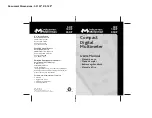
7
c.
When checking in-circuit resistance, be sure the circuit under test has all power
removed and that all capacitors have been discharged fully.
d.
200MΩrange short display appox.10 digits, measuring value = displayed value – 10
digits, eg. Measuring 100MΩ, displayed value is 101.0, then the correct value will be
101.0 – 1.0 = 100.0MΩ.
6. Measuring Capacitance
Connect black test lead to COM jack and red to mA jack; put the capacitance to the end
of test leads, pay attention on polarity.
NOTE
a.
The meter may take a few seconds to stabilize reading, this is normal for high
capacitance measuring.
b.
Do not connect an external voltage or a charged capacitance (especially high
capacitance) to the testing terminals.
c.
Once the high capacitance with serious leakage or breakdown, the measuring value
will be not stable
7. Measuring Transistor hFE
1>
Set the rotary switch to hFE range position.
2>
Determine whether the transistor under testing is NPN or PNP and locate the emitter,
base and collector leads. Insert the leads into proper holes of hFE socket on the front
panel. Display the approximate hFE value at the testing condition of base current
Ib10uA and Vce 3V.
8.
Measuring Diode
1>
Connect the black test lead to “COM” jack and the red to “VΩmA ”jack. (the polarity of
red lead is ‘+’)
2>
Set the rotary switch at the “
” range position, Connect the red lead to the anode
and the black lead to
NOTE
a.
If the lead connection is reversed, meter displayed over-range
b.
The meter will show approximate forward voltage drop of the diode.
9.
Measuring Continuity
1>
Connect the black test lead to COM jack and set the rotary switch at the
range
position, connect the red lead to the anode and the black lead to the cathode of the
diode under testing.
2>
If resistance less than about 50Ω, built-in buzzer will be sound.
Summary of Contents for DM 81
Page 1: ...1...


























